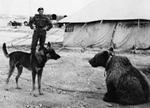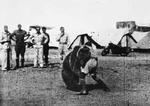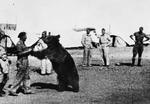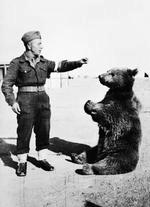Wojtek the Soldier Bear
Contributor: John Radzilowski
 Wojtek "the soldier bear" was only known animal enlisted as a regular rank soldier in World War II. He served with the Polish Second Corps during the Italian Campaign and gained fame for his role in Battle of Monte Cassino in 1944.
Wojtek "the soldier bear" was only known animal enlisted as a regular rank soldier in World War II. He served with the Polish Second Corps during the Italian Campaign and gained fame for his role in Battle of Monte Cassino in 1944.
In 1942, large numbers of Polish refugees were released from the Soviet Union where they had been imprisoned by the Soviets from 1930 to 1941. Many were Polish prisoners of war captured during the Nazi-Soviet invasion of Poland in 1939. Others were civilians, among the estimated 1.5 million Poles deported on Stalin's orders from eastern Poland to Soviet Gulags and concentration camps. Following the German attack on the Soviet Union in 1941, many of the captives who had survived the Gulags were released and made their way out of the Soviet Union via Persia and the Middle East where the former POWs and military-aged refugees were retrained for the war effort.
In the spring of 1942, at a transit camp in northern Persia, a group of young Polish soldiers came across a local shepherd boy who had found an orphaned bear cub. The soldiers bought the cub from the boy and named it Wojtek (a diminutive of Wojciech [Eng.: Adalbert] in Polish, which also means "happy warrior"). Wojtek was a Syrian brown bear (Ursus arctos syriacus) a species native to the Middle East and Caucasus Mountains. The cub, sickly and under nourished, was raised by the soldiers who improvised a way for it to suck condensed milk from a bottle. The bear grew quickly and was adopted as the mascot of the 22nd Transport Company (Artillery Transport) of the Polish Second Corps. For a group of men who had lost their country, their homes, and many members of their families, the bear proved a welcome morale booster.
By the time the unit moved to training camps in Palestine, Wojtek was a well-known figure, standing 6 feet tall and weighing close to 500 pounds. He would engage in wrestling matches with the men of his unit. He accompanied the men on all official duties, observing but never interfering. According to Second Corps veteran Dymitr Szawlugo "I soon became familiar with Wojtek (Voytek) the bear and we spent much time together. We all loved him and everyone enjoyed his company. He loved to drink from a beer bottle and when it was empty, he would look through the opening to see where the rest of the beer was. He would accept lit cigarettes, take a puff and swallow them. Once he got stung on the nose by a scorpion and became very ill. A few of us stayed with him all day and night to nurse him. We thought he would die. Many soldiers would not play with Wojtek as it got quite rough sometimes with people being scratched and uniforms getting torn. You had to know how to handle the bear and if you did no one got hurt. When enough was enough then we stopped play fighting." On one occasion, a local Arab infiltrated the Polish camp, either as a spy or a thief. Wojtek detected the intruder and cornered the terrified man until he was apprehended by military police.
In late 1943, as the Second Corps prepared to depart for the front lines in Italy, the question of Wojtek's status became urgent since it was forbidden to bring animal mascots on transport ships or into the war zone. The men of his company improvised and got Wojtek enlisted as a regular soldier with the rank of private and his own paybook and serial number. He accompanied his unit as a private throughout the Italian campaign.
In May 1944, the Polish Second Corps was given the task of dislodging the Nazi defenders from Monte Cassino. The fortified mountaintop position, held by elite paratroopers, was a key position on the German Gustav Line, dominating the Liri Valley and the road to Rome. Repeated Allied attacks on the position had been defeated with heavy losses. In May, Allied commanders sought once more to crack the German defense line and the untested Poles were given the task of storming Cassino. The battle commenced on May 11 and some of the bitterest fighting of the war ensued as units made up of former concentration camp prisoners fought hand to hand with the cream of Hitler's army. The Poles drove the defenders back but were stopped short of their objective by ferocious counterattacks, suffering heavy losses.
On May 17, the Poles mounted a final assault on Cassino. In preparation for the attack a massive artillery bombardment was to blanket the enemy lines and the Second Corps artillery was brought as close to the front lines as possible given the steep terrain. Veterans of the battle described the bombardment, which began on the night May 16/17, as "turning night into day." As Corps' guns fired nonstop, the men of 22nd Transport Company worked around the clock to ferry ammunition to the forward gun positions. After observing his comrades carrying heavy boxes of 25-pounder shells, "Private Wojtek" began picking up ammunition along with the men and carrying it to the front line. The bear continued this throughout the battle, apparently unconcerned by the noise of the shelling. By the morning of May 18, Cassino was in Allied hands. In recognition of his actions, the image of a bear carrying a heavy artillery shell was made the official emblem of the 22nd Transport Company.
Wojtek continued his service with the Second Corps through the rest of the war. Following the Soviet takeover of Poland, few members of the Second Corps sought to return home and many settled in England, as well as the United States and other countries. With his unit demobilized, Wojtek was sent to Edinburgh Zoo in Scotland where he would live out the remainder of his days in confinement. Since many of his former comrades settled in Scotland, they would visit Wojtek in the zoo. The bear would always perk up when he heard Polish spoken. His comrades would wait until the zoo staff left the area and then toss lit cigarettes and open bottles of beer into the bear's enclosure for him to enjoy. Wojtek died at the zoo in 1963.
In recent years, Wojtek has been the subject of short documentary films and honored with statues in Edinburgh and in Kraków, Poland.
Sources:
http://www.thesoldierbear.com
William Hageman, "A Bear You Can Look up To: Wojtek the World War II Soldier Bear," Chicago Tribune, Nov. 10, 2014, http://www.chicagotribune.com/lifestyles/pets/ct-pets-1110-soldier-bear-wojtek-20141110-story.html
Danny Kringiel, "Wojtek the Bear: The Nazis' Furriest Enemy," Der Spiegel International, July 13, 2012, http://www.spiegel.de/international/zeitgeist/wojtek-the-bear-that-joined-the-polish-army-and-fought-the-nazis-a-844056.html
Last Major Update: Apr 2016
Photographs
 |  |  |  |
Please consider supporting us on Patreon. Even $1 per month will go a long way! Thank you. Please help us spread the word: Stay updated with WW2DB: |
Visitor Submitted Comments
All visitor submitted comments are opinions of those making the submissions and do not reflect views of WW2DB.
Support WW2DB
and Honor Wojtek
with Shirts, Mugs, & Stickers
Teespring
- » 1,166 biographies
- » 337 events
- » 44,601 timeline entries
- » 1,243 ships
- » 350 aircraft models
- » 207 vehicle models
- » 376 weapon models
- » 123 historical documents
- » 261 facilities
- » 470 book reviews
- » 28,551 photos
- » 375 maps
Winston Churchill, 1935
Please consider supporting us on Patreon. Even $1 a month will go a long way. Thank you!
Or, please support us by purchasing some WW2DB merchandise at TeeSpring, Thank you!
15 Apr 2016 02:45:31 PM
There's a Polish song about him.